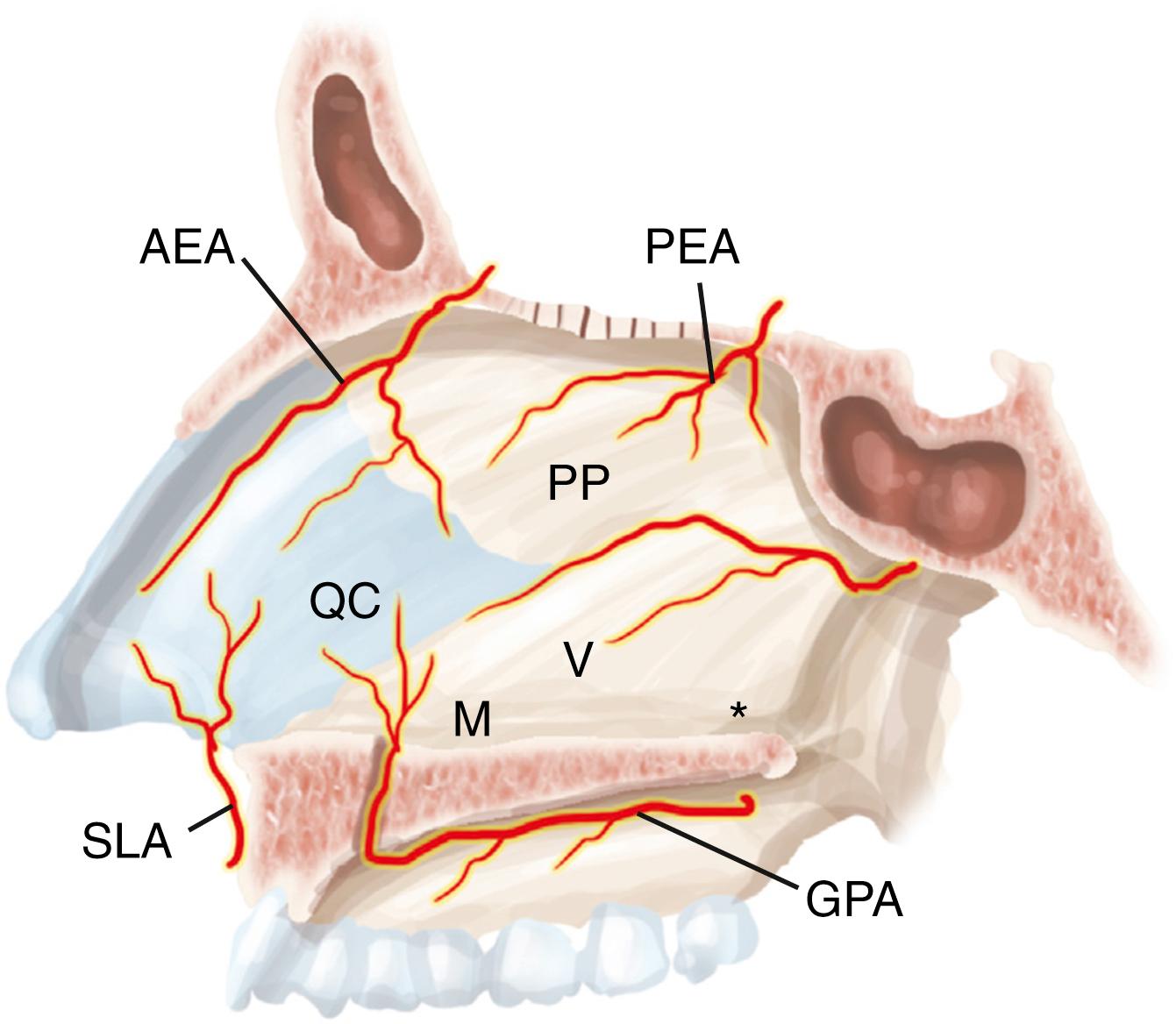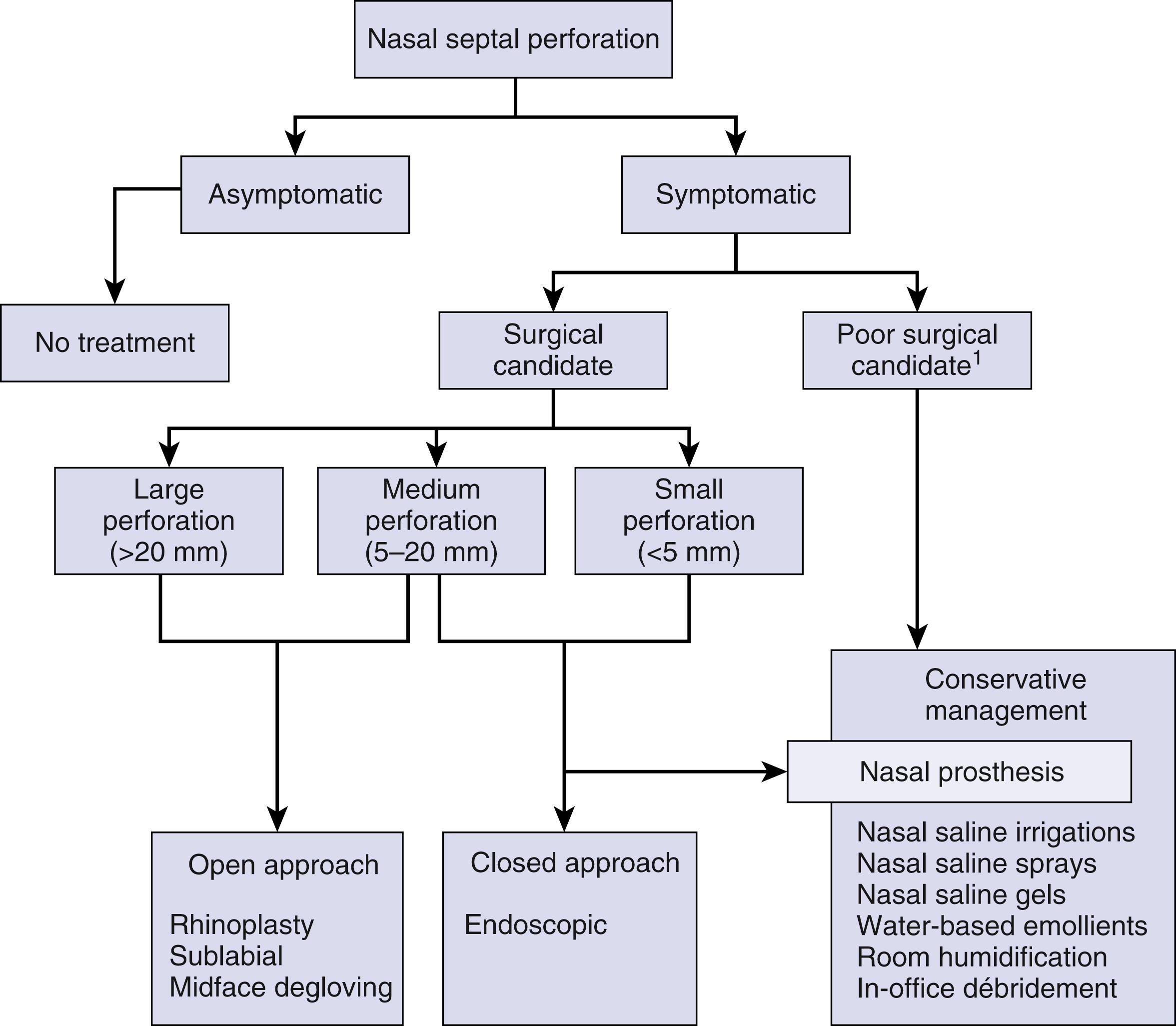Physical Address
304 North Cardinal St.
Dorchester Center, MA 02124
The nasal septum plays an important role in the structural and physiologic functions of the nose, contributing to nasal shape, appearance, and laminar airflow. The septum is made up of three distinct layers. Superficially, the mucosa is made up of ciliated respiratory epithelium. High in the nasal vault, in the region of the olfactory cleft, the mucosa is incorporated with specialized olfactory epithelium. Deep to this layer lies the mucoperichondrial/mucoperiosteal layers that contain the vascular network. Finally, the deepest layer is made up of a caudally located quadrangular cartilage and a confluence of bony projections posteriorly (vomer, perpendicular plate of the ethmoid, maxillary, and palatine bones).
The blood supply of the septum is a complex and robust anastomotic network derived from multiple sources. The primary supply is derived from terminal branches of the external carotid system, chiefly the internal maxillary artery, with secondary supply from the facial artery. The internal maxillary artery traverses the pterygopalatine fossa and enters the nose via the sphenopalatine foramen as the sphenopalatine artery. Posteriorly, the posterior septal branch of the sphenopalatine artery traverses the sphenoid rostrum to supply the septum. Inferiorly, the greater palatine artery, a branch of the internal maxillary artery, anastomoses with the inferior septal branches after traversing through the incisive foramen. Superiorly, the anterior and posterior ethmoid arteries, both branches of the ophthalmic artery, descend into the septum. Anteriorly, the superior labial artery, a branch of the facial artery, provides additional vasculature to the septum. Blood courses through this anastomosing network enveloped within the perichondrial and periosteal layers ( Fig. 96.1 ).

Disruption of this blood supply to the underlying avascular cartilage may lead to subsequent necrosis. If this occurs bilaterally, in opposing locations, a perforation may form. A nasal septal perforation is a sagittal-oriented, three-dimensional defect that involves the quadrangular cartilage and/or bone (perpendicular plate of the ethmoid, vomer, maxillary, and palatine bones), as well as the bilateral overlying respiratory epithelium (mucoperichondrium and mucoperiosteum) (see Fig. 96.1 ). The numerous causes of septal perforations can be categorized into traumatic, iatrogenic, infectious, inflammatory, neoplastic, vasoconstrictive, and caustic etiologies ( Box 96.1 ). Of all these listed, iatrogenic injury during septoplasty and nasal septal cauterization are the two most common causes.
Traumatic
External
Nasal septal fracture
Septal hematoma
Internal
Chronic nose picking
Nasal piercing
Iatrogenic ∗
Cautery ∗
Cranial base surgery
Intranasal packing
Nasal intubation
Nasogastric tube
Rhinoplasty
Septal splints
Septoplasty ∗
Sinus surgery
Turbinate surgery
Infectious
Invasive fungal sinusitis
Inflammatory
Nasally inhaled drugs (acetaminophen, opioids, methamphetamines, topical nasal corticosteroids)
Septal abscess (tuberculosis, syphilis, leprosy, rhinoscleroma, rhinosporidiosis)
Systemic disease (granulomatosis with polyangiitis, systemic lupus erythematosus, sarcoidosis, Churg-Strauss, polychondritis)
Vasculitides (granulomatosis with polyangiitis)
Neoplastic
Adenocarcinoma
Lymphoma
Melanoma
Squamous cell carcinoma
Vasoconstrictive
Cocaine
Topical nasal decongestants (oxymetazoline, phenylephrine)
Caustic
Agricultural dust (rice, grain)
Chemical (batteries, sulfuric acid, hydrochloric acid)
Heavy metal (chromium)
Industrial dusts (glass, lime)
Nasal septal perforations can also be categorized by size (in largest diameter) and location. Small perforations are defined as less than 5 mm, medium-sized perforations between 5 and 20 mm, and large perforations greater than 20 mm. Perforations may be located posteriorly or anteriorly. The middle turbinate attachment to the lateral nasal wall can be used as a landmark to differentiate anterior from posterior perforations.
Symptoms of nasal septal perforations are dependent on both the size and location of the perforation. In general, large and anterior perforations are the most symptomatic. Perforations located posteriorly tend to be asymptomatic even when large due to the high intranasal humidification within the posterior nasal cavity. Symptomatic patients often present with paradoxical nasal obstruction due to airflow turbulence created by diversion through the perforation. A consequence of this alteration in flow is mucosal desiccation at the margin of the perforation. This often leads to additional symptoms, such as chronic nasal crusting (at the perforation margins), recurrent epistaxis (mild to moderate in severity), exposed cartilage, pain (low-grade chondritis), malodor/cacosmia (infection), and rhinorrhea (compensatory) ( Box 96.2 ). Small anterior perforations can be a source of annoyance, causing nasal whistling, whereas large anterior perforations can lead to cosmetic deformity via loss of dorsal and columellar support. The reduction in nasal support leads to saddle nose deformity and columellar retraction respectively.
Chronic nasal crusting
Cosmetic deformity (i.e., saddle nose, columellar retraction)
Malodor (cacosmia)
Nasal obstruction
Nasal whistling
Pain
Recurrent epistaxis
Rhinorrhea
Freshening of the margin of the perforation is important in promoting re-epithelialization.
Elevation of intranasal flaps in the correct submucoperichondrial and submucoperiosteal plane is critical.
Tension-free closure of the mucosal flaps is important in preventing flap retraction.
Incorporation of an interposition graft during the repair of the septal perforations can provide a scaffold for re-epithelialization.
“What symptoms are you experiencing?”
Asymptomatic patients are not treated.
Symptomatic patients may be treated with conservative therapy or surgical repair.
“How severely do your symptoms impact your quality of life?”
Minor symptoms are treated conservatively.
Significant symptoms that do not respond to medical therapy may be treated surgically.
“What is your surgical history?”
This will determine whether the perforation was due to an iatrogenic injury and if there was a previous attempt at repair.
“What is your medical and facial trauma history?”
This will determine if the perforation was due to a traumatic, infectious, inflammatory, or neoplastic etiology.
In addition, significant comorbidities may reveal that a patient is not a candidate for a surgical procedure.
“Are you a smoker?” “Do you have a history of using cocaine, drug abuse, or the misuse of topical nasal medication?” “What is your occupation?”
Current smoking, nasal drug abuse, topical nasal medication misuse, and exposures in the work environment will affect the outcome of surgical repair.
“What medications do you take?”
Patients taking anticoagulants and herbal supplements that contribute to increased bleeding will make surgical repair difficult due to poor visualization.
Nasal endoscopy is the most important part of the physical examination.
Determine the location of the perforation.
Is it anterior, posterior, superior, or inferior?
Is there one perforation or multiple perforations?
Determine the shape of the perforation.
Is it circular or elliptical?
If the latter, is the longest dimension oriented anteriorly-posteriorly or superiorly-inferiorly?
Determine the size of the perforation.
Place a ruler in one nostril with the markings toward the septum. Place an angled rigid nasal endoscope in the contralateral nostril, and visualize the ruler through the perforation.
Assess the presence of underlying cartilage.
Palpate the septum manually and with a cotton-tip applicator.
Assess the mucosa.
Identify abnormalities that may suggest an underlying infectious, granulomatous/inflammatory, or neoplastic process.
Based upon the patient’s history and physical examination findings, we follow the treatment algorithm depicted in Fig. 96.2 . The first decision point is determining if the patient requires treatment. Asymptomatic patients do not require treatment. The second decision point is determining whether the symptomatic patient is a surgical candidate. Poor surgical candidates include patients who have medical conditions that prevent safe surgery, who continue to abuse nasal drugs, continue to misuse topical nasal medication, have an active infection, have uncontrolled inflammatory disease, or have untreated sinonasal neoplasms.

Symptomatic patients who are poor surgical candidates are offered conservative management. Conservative management focuses on alleviating symptoms through the routine use of nasal saline irrigations, nasal saline sprays, nasal saline gels, water-based emollients, room humidification, and, if needed, intermittent office visits for débridement.
Conservative management also includes the insertion of a nasal prosthesis after excellent topical anesthesia. Low-profile grommet buttons are easily cut and shaped to the patient’s needs and are typically well tolerated (see Chapter 1 ). Placement of the button is not difficult if done properly. The button may be purse-stringed using a suture or cut along one of the flanges so that it may be placed in a corkscrew fashion. Additional options include magnetic septal prosthetics that may allow easier clinic placement and removal, as well as adjustable two-piece buttons that accommodate multiple septal widths. Because septal buttons are foreign bodies, patients may experience nasal obstruction due to the thickness of the prosthesis, debris accumulation, or a local inflammatory reaction (i.e., mucosal edema, granulation tissue).
The third and final decision point is determining how to manage symptomatic patients who are surgical candidates. We recommend that small- and medium-sized perforations be treated with either a nasal prosthesis or through a closed (endoscopic) approach using intranasal flaps with an interposition graft. Large perforations are typically treated through an open approach using intranasal flaps with an interposition graft.
None. Imaging is not routinely performed unless there is concern for an underlying systemic, granulomatous, or neoplastic process that may be contributing to the septal perforation.
Nasal obstruction
Recurrent epistaxis
Chronic nasal crusting
Pain
Malodor/cacosmia
Rhinorrhea
Nasal whistling
Cosmetic deformity (i.e., saddle nose, columellar retraction)
Medical comorbidities that would preclude general anesthesia
Continued nasal drug abuse (i.e., cocaine, opioids, methamphetamines)
Continued misuse of topical nasal medications (i.e., oxymetazoline, phenylephrine)
Acute infections (i.e., acute rhinosinusitis, invasive fungal sinusitis)
Uncontrolled inflammatory disease (i.e., granulomatosis with polyangiitis, sarcoidosis, systemic lupus erythematous)
Sinonasal malignancies
Controlled inflammatory disease
Previous sinonasal radiation therapy
Active tobacco smoking
Become a Clinical Tree membership for Full access and enjoy Unlimited articles
If you are a member. Log in here